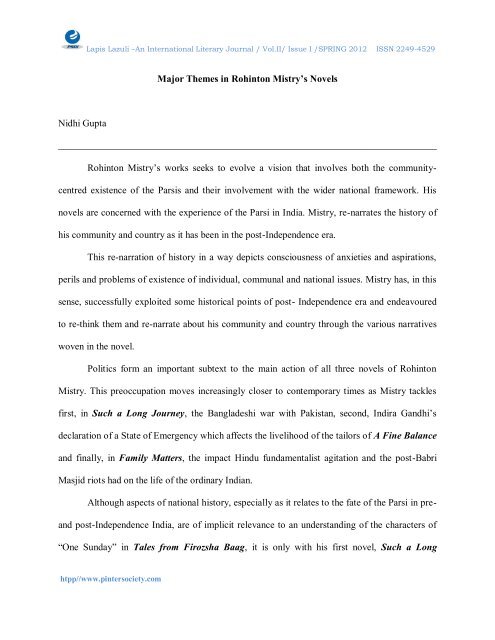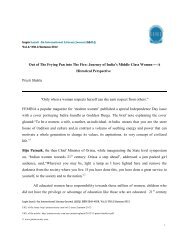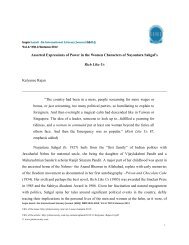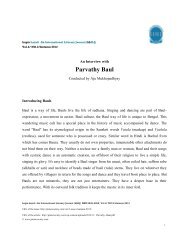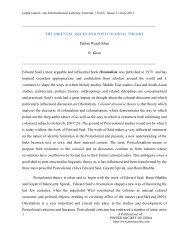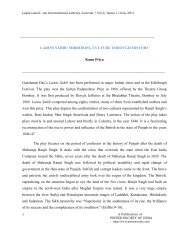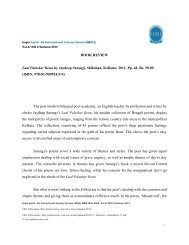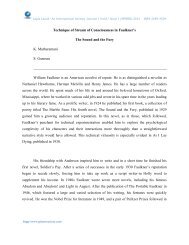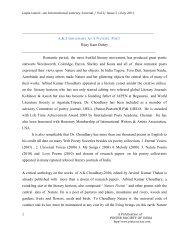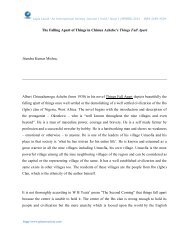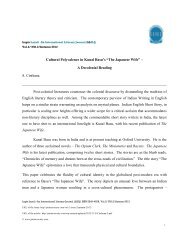Major Themes in Rohinton Mistry's Novels Nidhi Gupta - lapis lazuli
Major Themes in Rohinton Mistry's Novels Nidhi Gupta - lapis lazuli
Major Themes in Rohinton Mistry's Novels Nidhi Gupta - lapis lazuli
Create successful ePaper yourself
Turn your PDF publications into a flip-book with our unique Google optimized e-Paper software.
<strong>Nidhi</strong> <strong>Gupta</strong><br />
Lapis Lazuli –An International Literary Journal / Vol.II/ Issue I /SPRING 2012 ISSN 2249-4529<br />
htpp//www.p<strong>in</strong>tersociety.com<br />
<strong>Major</strong> <strong>Themes</strong> <strong>in</strong> Roh<strong>in</strong>ton Mistry’s <strong>Novels</strong><br />
______________________________________________________________________________<br />
Roh<strong>in</strong>ton Mistry‘s works seeks to evolve a vision that <strong>in</strong>volves both the community-<br />
centred existence of the Parsis and their <strong>in</strong>volvement with the wider national framework. His<br />
novels are concerned with the experience of the Parsi <strong>in</strong> India. Mistry, re-narrates the history of<br />
his community and country as it has been <strong>in</strong> the post-Independence era.<br />
This re-narration of history <strong>in</strong> a way depicts consciousness of anxieties and aspirations,<br />
perils and problems of existence of <strong>in</strong>dividual, communal and national issues. Mistry has, <strong>in</strong> this<br />
sense, successfully exploited some historical po<strong>in</strong>ts of post- Independence era and endeavoured<br />
to re-th<strong>in</strong>k them and re-narrate about his community and country through the various narratives<br />
woven <strong>in</strong> the novel.<br />
Politics form an important subtext to the ma<strong>in</strong> action of all three novels of Roh<strong>in</strong>ton<br />
Mistry. This preoccupation moves <strong>in</strong>creas<strong>in</strong>gly closer to contemporary times as Mistry tackles<br />
first, <strong>in</strong> Such a Long Journey, the Bangladeshi war with Pakistan, second, Indira Gandhi‘s<br />
declaration of a State of Emergency which affects the livelihood of the tailors of A F<strong>in</strong>e Balance<br />
and f<strong>in</strong>ally, <strong>in</strong> Family Matters, the impact H<strong>in</strong>du fundamentalist agitation and the post-Babri<br />
Masjid riots had on the life of the ord<strong>in</strong>ary Indian.<br />
Although aspects of national history, especially as it relates to the fate of the Parsi <strong>in</strong> pre-<br />
and post-Independence India, are of implicit relevance to an understand<strong>in</strong>g of the characters of<br />
―One Sunday‖ <strong>in</strong> Tales from Firozsha Baag, it is only with his first novel, Such a Long
Lapis Lazuli –An International Literary Journal / Vol.II/ Issue I /SPRING 2012 ISSN 2249-4529<br />
Journey that Mistry foregrounds aspects of national politics and <strong>in</strong>tegrates them <strong>in</strong>to the ma<strong>in</strong><br />
plot of his narrative. With A F<strong>in</strong>e Balance, he reproduces his concerns about the imbrication of<br />
national politics and the fate of the <strong>in</strong>dividual. However, <strong>in</strong> Family Matters, because of the more<br />
<strong>in</strong>timate nature of his fictional terra<strong>in</strong>, state politics, though present, affect the ma<strong>in</strong> narrative<br />
only towards the end.<br />
Such a Long Journey is set aga<strong>in</strong>st the backdrop of the Bangladesh—Pakistan wars of<br />
the 1970s. In this novel, public events have direct repercussions on the life of the ord<strong>in</strong>ary<br />
citizen. S<strong>in</strong>ce the wars are a narrative excuse for the exploration of both political ethics and the<br />
problems of <strong>in</strong>dividual ethical-moral responsibility, an explanatory note on the historical events<br />
is <strong>in</strong> order.<br />
Such a Long Journey is the story of Gustad Noble who lives <strong>in</strong> Parsi compound with his<br />
wife and three children. A bank empoloyee, he commands respect <strong>in</strong> the compound. He is greatly<br />
loved by Tehmul-Lungraa- the lame man who also lives <strong>in</strong> the compound. D<strong>in</strong>shawji is Gustad‘s<br />
close friend, whom he meets every day. Gustad nurses a silent pa<strong>in</strong> caused by the disappearance<br />
of his former close friend, Jimmy Bilimoria, which he sees as betrayal. Until one day, missive<br />
comes from Bilimoria ask<strong>in</strong>g him to transfer some money to a new account. Reluctantly Gustad<br />
obliges, after hav<strong>in</strong>g unsuccessfully tried to return the money. Bilimoria is <strong>in</strong>volved <strong>in</strong> a national<br />
plot with political ramifications. He is arrested and imprisoned and when Gustad visits him, he<br />
listens to the helpless narrative of the dy<strong>in</strong>g man and surmises that he himself has been used. As<br />
he copes with the problems on the home front-the grow<strong>in</strong>g pa<strong>in</strong>s of his adolescent sons, the<br />
frailty of his young daughter (which implies further demands on an already stra<strong>in</strong>ed household<br />
budget)-he attempts to improve their liv<strong>in</strong>g conditions by ask<strong>in</strong>g a pavement artist to pa<strong>in</strong>t the<br />
htpp//www.p<strong>in</strong>tersociety.com
Lapis Lazuli –An International Literary Journal / Vol.II/ Issue I /SPRING 2012 ISSN 2249-4529<br />
wall of their compound. This wall becomes the focus of municipal attention and will be witness<br />
to the f<strong>in</strong>al movement of the novel. As a procession to demand better sewage facilities stops <strong>in</strong><br />
front of what has become a wall of all religions, Tehmul dies. Sohrab reconciles with his father<br />
as the latter breaks down and cries <strong>in</strong> front of the corpse of the unwanted Tehmul for all the<br />
deaths he has stoically faced dry-eyed: his mother‘s, Bilimoria‘s and D<strong>in</strong>shawji‘s.<br />
Historically, the Parsis came to India after the Arab conquest of Iran and their po<strong>in</strong>t of<br />
entry was Gujarat. The Parsis were active <strong>in</strong> the world of bus<strong>in</strong>ess and politics. Dadabhai Naoroji<br />
and Madame Cama were prom<strong>in</strong>ent Parsis <strong>in</strong> India‘s freedom movement. Accord<strong>in</strong>g to T.M.<br />
Luhrmann, the Parsis were <strong>in</strong>fluential player dur<strong>in</strong>g the British Raj. They viewed the issue of<br />
<strong>in</strong>dependence with mixed feel<strong>in</strong>gs s<strong>in</strong>ce many of them identified with Western culture. There<br />
was regret for the pass<strong>in</strong>g of an old way of life (dur<strong>in</strong>g the Raj) and they l<strong>in</strong>ked their changed<br />
social fortunes to the departure of the British. (The Good, 14) This theme is <strong>in</strong>terspersed<br />
throughout the stories, from the pitiful figure of Najamai <strong>in</strong> ―Swimm<strong>in</strong>g Lessons‖ to the ord<strong>in</strong>ary<br />
heroism of the pathos-filled figure of Gustad Noble <strong>in</strong> Such a Long Journey.<br />
The narratives of A F<strong>in</strong>e Balance and Family Matters grow simultaneously more<br />
<strong>in</strong>timate and more closely concerned with the <strong>in</strong>ner life and complex experiences of the<br />
protagonists, while paradoxically, also more concerned with contemporary social and political<br />
contexts.<br />
In Mistry‘s novels, we can easily f<strong>in</strong>d <strong>in</strong>terconnectedness of various themes like theme of<br />
nationalism, alienation, oppression, human-relationship, fear and temptation. The homelessness<br />
of Ishvar and Om <strong>in</strong> the city makes them victims of the central government‘s plans for a city<br />
beautification-project endorsed by people of the middle class such as Nusswan Shroff and Mrs.<br />
htpp//www.p<strong>in</strong>tersociety.com
Lapis Lazuli –An International Literary Journal / Vol.II/ Issue I /SPRING 2012 ISSN 2249-4529<br />
<strong>Gupta</strong>, the manager of Au Revoir Exports—people who have absolutely no idea of the misery of<br />
the absolute poor, the dispossessed and the disempowered. Unlike these two, D<strong>in</strong>a Dalal (whose<br />
fortunes beg<strong>in</strong> to change with the death of her father) becomes martyr and servant to her<br />
brother‘s family, and is left to fend for herself. D<strong>in</strong>a‘s relationship with the two tailors is at first<br />
one of distrust and tyranny as she forces them to work long hours without know<strong>in</strong>g that they go<br />
without food. She forbids Maneck, a ―nice Parsi boy‖ from socializ<strong>in</strong>g with them. But the<br />
barriers gradually disappear as they all get to know each other. The bond between the four<br />
becomes stronger after their horrific experiences at the construction plant. D<strong>in</strong>a Dalal allows the<br />
tailors to sleep on the terrace of her t<strong>in</strong>y flat. But this promise of happ<strong>in</strong>ess is soon to be<br />
destroyed.<br />
Ishvar, who believes <strong>in</strong> the tradition of with marry<strong>in</strong>g young, persuades his nephew, Om<br />
that despite their difficult material circumstances, he ought to marry a girl from their village.<br />
This return to the village marks the onset of their sorrows. Om‘s youthful challenge of the<br />
supremacy of the oppressive Thakur, who had murdered his whole family leads to his castration<br />
by the politicians. Ishvar, who had earlier been sterilized along with his nephew under the central<br />
government‘s Family Plann<strong>in</strong>g Programme, loses his legs to gangrene. Both Om and Ishvar<br />
make their way back to the city where D<strong>in</strong>a has lost the battle aga<strong>in</strong>st the landlord and f<strong>in</strong>ally<br />
allowed herself to be evicted from her flat. D<strong>in</strong>a‘s resignation is the effect of a misapprehension<br />
on her part. She believes that the tailors, who are actually caught up <strong>in</strong> the caste turmoil <strong>in</strong> their<br />
village, have deserted her. She also believes that Maneck, who files away to Dubai, hav<strong>in</strong>g failed<br />
his exams, has also deserted her. She allows Nusswan‘s family to take over her dest<strong>in</strong>y and<br />
convert her <strong>in</strong>to an unpaid family servant. When Maneck returns to Bombay eight years later, the<br />
htpp//www.p<strong>in</strong>tersociety.com
Lapis Lazuli –An International Literary Journal / Vol.II/ Issue I /SPRING 2012 ISSN 2249-4529<br />
city is <strong>in</strong> the throes of a new form of madness—the kill<strong>in</strong>g of Sikhs <strong>in</strong> the wake of the Prime<br />
M<strong>in</strong>ister‘s assass<strong>in</strong>ation. Even though this proof of human madness saddens him, it does not<br />
shatter him as much as discover<strong>in</strong>g the fate of D<strong>in</strong>a and the tailors does. It is, for him, the f<strong>in</strong>al<br />
proof of the chaos of the world. He had earlier described God thus:<br />
htpp//www.p<strong>in</strong>tersociety.com<br />
I prefer to th<strong>in</strong>k that God is a giant quilt maker. With an <strong>in</strong>f<strong>in</strong>ite variety of<br />
designs. And the quilt has grown so big and confus<strong>in</strong>g, the pattern is impossible to<br />
see, the squares and diamonds and triangle don‘t fit so well together anymore, and<br />
it‘s all become mean<strong>in</strong>gless. So He has abandoned it. (418)<br />
Theme of Communitarianism along with the politics <strong>in</strong> Mistry‘s novel is a f<strong>in</strong>e<br />
documentation of the human dimensions of the Emergency. Mistry could have made the tailors<br />
<strong>in</strong>habitants of the city who suffer from such torture. But br<strong>in</strong>g<strong>in</strong>g <strong>in</strong> people from the village<br />
allows him to document new areas of the varied sub - cont<strong>in</strong>ental social reality-poverty prejudice<br />
and caste oppression <strong>in</strong> the villages, <strong>in</strong>ter-communal harmony or its obverse and the terrible<br />
predicament of honest hard-work<strong>in</strong>g villagers who become a mass of statistics <strong>in</strong> the city. The<br />
two tailors, who represent common humanity as they endure the consequences of all the political<br />
measures decided <strong>in</strong> the higher echelons of power, are Om and Ishvar Darji, Chamaars-turned-<br />
tailors from the countryside. Once <strong>in</strong> the city, Om and Ishvar can only jo<strong>in</strong> the masses look<strong>in</strong>g<br />
for jobs and shelter. When they <strong>in</strong>itially have to sleep under the awn<strong>in</strong>g of the shop of Ashraf<br />
Chacha‘s suspicious friend, Nawaz, they th<strong>in</strong>k it is but a temporary measure. Soon, they f<strong>in</strong>d out<br />
that this temporary measure will last for three months, for jobs are not easy to come by. Their<br />
next stop is the slum quarter where they encounter for the first time the horrendous experience of<br />
the poor city migrant. A poor shack is sublet to them by an agent manipulat<strong>in</strong>g state lands, where<br />
illegal shacks are erected and rented out to the desperate. This is hardly any comfort but it
Lapis Lazuli –An International Literary Journal / Vol.II/ Issue I /SPRING 2012 ISSN 2249-4529<br />
ensures a roof over the head. At the jhopadpattys, Om and Ishvar have to <strong>in</strong>teract with a curious<br />
group of people. It is here that they experience water shortage, the dire poverty of those even<br />
worse off than them, like the Monkey-man who cannot leave his animals alone for fear they will<br />
devour each other out of hunger, and the poor battered woman with five children to feed.<br />
As the foursome break up, each to their own fate, the sway of national politics takes over.<br />
Om, Ishvar and D<strong>in</strong>a have to earn their livelihood with<strong>in</strong> the very structures of societal<br />
oppression they had set out to challenge. When Maneck comes back from Dubai, he returns at<br />
the peak of anti-Sikh riots <strong>in</strong> the madness follow<strong>in</strong>g Indira Gandhi‘s assass<strong>in</strong>ation. The driver<br />
who transports him is one who has had to disguise himself to hide his Sikh identity. The madness<br />
of communal riots has surface aga<strong>in</strong> and aga<strong>in</strong> <strong>in</strong> post-Independence India. Beyond the causes of<br />
riots, the politics of riot<strong>in</strong>g demands a reassessment of the politics of identity with<strong>in</strong><br />
multicultural, secular India.<br />
The political theme of Family Matters is expressed through the figures of Yezad and his<br />
employer – the idealistic Mr. Kapur – and their lives. Mr. Kapur has dreams of reform<strong>in</strong>g the<br />
city, mak<strong>in</strong>g it safer for the ord<strong>in</strong>ary citizen. From the time of his first appearance, he talks of<br />
contest<strong>in</strong>g the Municipal elections <strong>in</strong> order to deal with lawlessness, and act<strong>in</strong>g as a buffer<br />
aga<strong>in</strong>st the fundamentalist H<strong>in</strong>dutva agenda of Shiv Sena apologists.<br />
Mistry‘s critique of Indian communal politics <strong>in</strong> this novel is rarely about the public<br />
doma<strong>in</strong>. Unlike Such a Long Journey where political figures and events occur prom<strong>in</strong>ently <strong>in</strong><br />
the public sphere, Family Matters shows the events at the level of the local and the familial.<br />
Communal politics and disturbances affect the common man (<strong>in</strong> this case, Yezad) though he is <strong>in</strong><br />
no way <strong>in</strong>volved <strong>in</strong> sectarian strife, or even local politics. Mistry shows how fundamentalism and<br />
htpp//www.p<strong>in</strong>tersociety.com
Lapis Lazuli –An International Literary Journal / Vol.II/ Issue I /SPRING 2012 ISSN 2249-4529<br />
skewed political th<strong>in</strong>k<strong>in</strong>g have altered the very social structure <strong>in</strong> such a way that even the<br />
common man – dissociated from politics – is scared and affected.<br />
Beyond the concern with the right-w<strong>in</strong>g politics of the H<strong>in</strong>du majority, Family Matters<br />
also deals with larger issues of religious zealotry, bigotry and fundamentalism with<strong>in</strong> all<br />
communities. The Parsi community is not spared criticism – Nariman Vakeel‘s parents and their<br />
cohort of friends who are zealously religious and exclusivist Parsis, and the f<strong>in</strong>al transformation<br />
of liberal Yezad <strong>in</strong>to a fundamentalist religious bigot.<br />
It is the perfect canvas to explore the politics of the <strong>in</strong>dividual <strong>in</strong> relation to the<br />
community. In Mistry‘s earlier fiction, characters like Sohrab <strong>in</strong> Such a Long Journey and D<strong>in</strong>a<br />
Dalal <strong>in</strong> A F<strong>in</strong>e Balance emerge as strongly <strong>in</strong>dividualistic people who struggle to carve a<br />
personal, <strong>in</strong>dividual space for themselves with<strong>in</strong> the family whole. In the case of Sohrab, his<br />
rebellion is aga<strong>in</strong>st his father‘s dreams for his future, to which he is eventually reconciled as he<br />
realizes the older man only wishes his well-be<strong>in</strong>g. In the case of D<strong>in</strong>a dalal, her rebellion is both<br />
that of a disempowered woman and a sister aga<strong>in</strong>st a wealthy and manipulative brother.<br />
However, it is only <strong>in</strong> Family Matters that the question of the private space of <strong>in</strong>dividual<br />
identity is fully explored through the many <strong>in</strong>stances of conflict between <strong>in</strong>dividual desires and<br />
duties towards the family or community. The foremost of these is the tragic story of Nariman<br />
Vakeel. He is forcefully separated from his Christian girlfriend by his parents and their well-<br />
wishers and forced to bend to the general demand of the community. This is presented as a<br />
submission of his will to the higher good: ―No happ<strong>in</strong>ess is more last<strong>in</strong>g than the happ<strong>in</strong>ess that<br />
you get from fulfill<strong>in</strong>g your parents‘ wisher‖. (FM, 13) But Nariman accepts the separation from<br />
Lucy out of wear<strong>in</strong>ess and a sense of the futility of the unequal struggle: ―They had been ground<br />
htpp//www.p<strong>in</strong>tersociety.com
Lapis Lazuli –An International Literary Journal / Vol.II/ Issue I /SPRING 2012 ISSN 2249-4529<br />
down by their families, exhausted by the stra<strong>in</strong> of it‖. (13) Nariman‘s parents see education as<br />
the cause of sorrow: ―Modern ideas have filled Nari‘s head. He never learned to preserve that<br />
f<strong>in</strong>e balance between tradition and moderness‖. (15) This theme of coercion exercised by the<br />
family is repeated <strong>in</strong> a different context with Jal, Nariman‘s stepson.<br />
Nostalgia is a recurrent theme <strong>in</strong> Mistry‘s fiction. This nostalgia is generally for a past<br />
way of life, forever lost to the ma<strong>in</strong> characters. It is occasionally manifest <strong>in</strong> the idealization of<br />
religious rituals which are seen as a way to preserve the past and prevent the dis<strong>in</strong>tegration of the<br />
family and the community. It also takes the form of rem<strong>in</strong>isc<strong>in</strong>g about childhood which is seen<br />
as a more stable and reassur<strong>in</strong>g world than the present. These rem<strong>in</strong>iscences, presented <strong>in</strong> the<br />
stories of various characters <strong>in</strong> both the short stories and the novels, are l<strong>in</strong>ked to the changed<br />
circumstances of the Parsi community follow<strong>in</strong>g Independence. This politico-cultural nostalgia<br />
helps to create a sense of loss about the changed circumstances of the characters <strong>in</strong> both domestic<br />
and public spheres.<br />
All of Mistry‘s texts play with the boundaries of the private and the public. Most of<br />
Mistry‘s ma<strong>in</strong> protagonists, such as Gustad and Yezad, <strong>in</strong>habit the two realms simultaneously,<br />
while test<strong>in</strong>g the boundaries of both. The public world is the world of the ord<strong>in</strong>ary citizen,<br />
consist<strong>in</strong>g of friends, acqua<strong>in</strong>tances and the professional space of work where these adult<br />
relationships are forged. As the earlier we have <strong>in</strong>dicated, the themes of politics, history and<br />
community are <strong>in</strong>tegral to the life of Mistry‘s characters. The private world is the space of the<br />
home and the family, <strong>in</strong>habited mostly by women and children.<br />
Age is a central theme <strong>in</strong> Mistry‘s fiction and relationships between and across<br />
generations is a major concern whenever Mistry discusses the private realm of the family and the<br />
htpp//www.p<strong>in</strong>tersociety.com
Lapis Lazuli –An International Literary Journal / Vol.II/ Issue I /SPRING 2012 ISSN 2249-4529<br />
household. The private world is where the family gathers. In Mistry‘s fiction, it consists of the<br />
world of the old and the young. Women dom<strong>in</strong>ate the private realm with their nurtur<strong>in</strong>g attention<br />
and the hard labour through which the stability of the family is ensured.<br />
Immigration is a recurr<strong>in</strong>g theme <strong>in</strong> Mistry‘s fiction from his short stories to the latest<br />
novel Family Matters where Yezad narrates to his two sons his unsuccessful experiences with<br />
bureaucracy <strong>in</strong> his young adolescent days as he attempted to go to the West. Thus, expectations<br />
about the <strong>in</strong>evitability of migration are very strong. But he can neither feel his brother‘s<br />
nationalist commitment nor Jamshed‘s alienation. His migration is a pre-orda<strong>in</strong>ed trajectory that<br />
he undertakes, not out of enthusiasm but because it has to be.<br />
We can very well see the theme of alienation, fear and temptation <strong>in</strong> the story of D<strong>in</strong>a‘s<br />
struggles aga<strong>in</strong>st the social conditions of her existence could easily have existed <strong>in</strong>dependent of<br />
the long <strong>in</strong>cursion <strong>in</strong>to the life of the tailors. As such they would have existed, with<strong>in</strong> the<br />
absurdist frame of an illogical universe, as ever-endur<strong>in</strong>g puppets. It is through these people and<br />
events that the novel tackles the immediate consequences of the ―City Beautification‖, ―Garibi<br />
Hatao‖ and ―Family Plann<strong>in</strong>g‖ schemes. Their tragic-comic fates are apt illustrations of the<br />
absurdity of human existence, where human will have no power over the illogical course of<br />
events. Both Om and Ishvar are presented as fully rounded human characters. Om is impulsive,<br />
easily irritated and always has to be called back to practical reality by his uncle. Early <strong>in</strong> the<br />
story, when they learn of the massacre of the family, Om dreams of ‗Dalit‘ revenge. He has to be<br />
persuaded of the impracticality of this scheme by Ishvar.<br />
Mistry recognizes the significance of religion and ritual <strong>in</strong> the construction of human<br />
identity. He, therefore, use religion, ritual and the responses to these as a central theme <strong>in</strong> his<br />
htpp//www.p<strong>in</strong>tersociety.com
Lapis Lazuli –An International Literary Journal / Vol.II/ Issue I /SPRING 2012 ISSN 2249-4529<br />
fiction. In fact, rituals and religious beliefs become the markers of ethnic, racial and<br />
communitarian identities; they highlight difference. Mistry‘s fiction can be read with<strong>in</strong> this<br />
framework as the predicament of an <strong>in</strong>dividual as he/she seeks to cope with the contradictions of<br />
the past and the present, community and self, family and community. Each of these ‗contexts‘ of<br />
<strong>in</strong>dividual contradictions and dilemmas is an emotionally-charged event <strong>in</strong> his work.<br />
Mistry‘s novels are a marvelous showcase of relationships, and this can be observed<br />
under the theme of human-relationship.<br />
Mistry reveals the fragility of human relationships <strong>in</strong> ―The Collectors‖. He suggests that<br />
relationships are extremely tenuous and that the trust that cements these is easily broken or<br />
damaged. A misunderstand<strong>in</strong>g and a degree of paranoia (which all his characters seem to<br />
possess/suffer from) can cause the breakdown of relationships and even lead to oppression.<br />
In A F<strong>in</strong>e Balance we can see the middle class and the anonymous, faceless work<strong>in</strong>g<br />
class meet sympathize with each other, and learn to overcome their prejudices and forge bonds of<br />
friendship, affection and humanity. In an <strong>in</strong>terview, Mistry stated that this novel started with an<br />
image – a woman at a sew<strong>in</strong>g mach<strong>in</strong>e- and was later expanded to <strong>in</strong>clude the tailors, to br<strong>in</strong>g <strong>in</strong><br />
the horror of caste exploitation and violence of rural India, and the figure of Maneck Kohlah<br />
from Kashmir. All of these characters, together with D<strong>in</strong>a Dalal- the fiery-tempered, <strong>in</strong>telligent,<br />
fiercely <strong>in</strong>dependent and prematurely aged young woman- constitute a small world of recreated<br />
family of the novel.<br />
Thematically, Mistry‘s fiction has moved from the family <strong>in</strong> Tales from Firozsha Baag<br />
to the wider Parsi community <strong>in</strong> Such a Long Journey to the national tapestry <strong>in</strong> A F<strong>in</strong>e<br />
Balance. Family Matters moves back to the theme of the family and uses narrative strategies<br />
htpp//www.p<strong>in</strong>tersociety.com
Lapis Lazuli –An International Literary Journal / Vol.II/ Issue I /SPRING 2012 ISSN 2249-4529<br />
first used <strong>in</strong> A F<strong>in</strong>e Balance to <strong>in</strong>tensify the plot, the human <strong>in</strong>terest and the sense that the<br />
characters are firmly embedded <strong>in</strong> their present.<br />
htpp//www.p<strong>in</strong>tersociety.com<br />
Works Cited<br />
1. Luhrmann, T.M., The Good Parsi: The Fate of a Colonial Elite <strong>in</strong> a Postcolonial Society,<br />
Cambridge, Mass: Harvard University Press, 1996.<br />
2. Mistry, Roh<strong>in</strong>ton. Family Matters, London: Faber and Faber, 2002.<br />
3. ______________. Tales from Firozsha Baag,New Delhi: Pengu<strong>in</strong> Books India Ltd, 1994.<br />
4. ______________. Such a Long Journey, London: Faber & Faber, 1991.<br />
5. ______________. A F<strong>in</strong>e Balance, London: Faber and Faber, 1995.
Lapis Lazuli –An International Literary Journal / Vol.II/ Issue I /SPRING 2012 ISSN 2249-4529<br />
6. Robert, Mc Lay. ‗Roh<strong>in</strong>ton Mistry talks to Robert Mc Lay‘ Wasafiri. 23, 1996.<br />
7. S<strong>in</strong>gh, A.K. Contemporary Indian Fiction In English, New Delhi: Creative Books, 1993<br />
About the Author<br />
<strong>Nidhi</strong> <strong>Gupta</strong>, Ex.Asst.Prof at JPIET, Meerut. Recently an educator, USA<br />
htpp//www.p<strong>in</strong>tersociety.com


